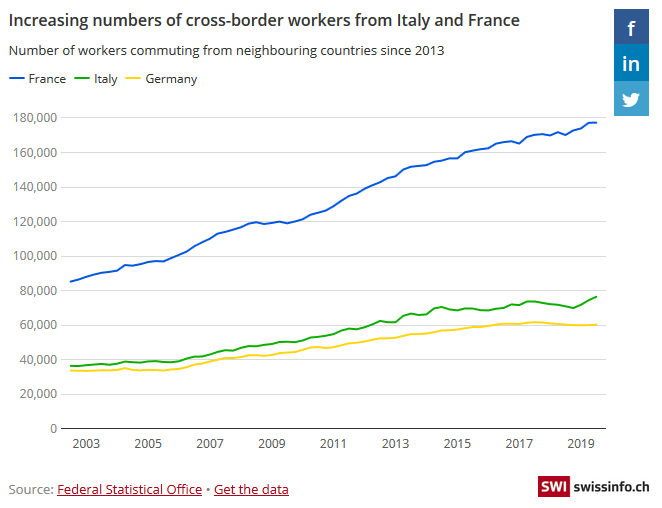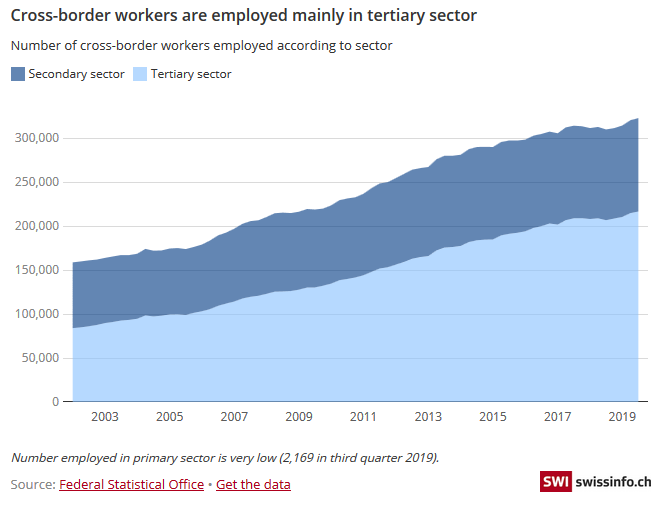The number of people from neighbouring countries commuting to Switzerland for work each day reached a record 325,000 this year. The increase was felt especially in cantons Ticino and Geneva. Following a slight drop in 2018, the Swiss job market is once again attracting cross-border workers in historically high numbers. Some 325,291 peopleexternal link entered the country each day in the third quarter of 2019, beating the previous record of 316,491 set in 2017. Experts attribute the upward trend in large part to the stable Swiss economy and a stable labour market. + Learn more about the phenomenon of cross-border workers in Switzerland Leading the jump in cross-border workers are French residents (+7,166 in a year) and Italians (+5,551). The number
Topics:
Swissinfo considers the following as important: 3) Swiss Markets and News, 3.) Swiss Info, Featured, newsletter, Work
This could be interesting, too:
Eamonn Sheridan writes CHF traders note – Two Swiss National Bank speakers due Thursday, November 21
Charles Hugh Smith writes How Do We Fix the Collapse of Quality?
Marc Chandler writes Sterling and Gilts Pressed Lower by Firmer CPI
Michael Lebowitz writes Trump Tariffs Are Inflationary Claim The Experts
|
The number of people from neighbouring countries commuting to Switzerland for work each day reached a record 325,000 this year. The increase was felt especially in cantons Ticino and Geneva. Following a slight drop in 2018, the Swiss job market is once again attracting cross-border workers in historically high numbers. Some 325,291 peopleexternal link entered the country each day in the third quarter of 2019, beating the previous record of 316,491 set in 2017. Experts attribute the upward trend in large part to the stable Swiss economy and a stable labour market. + Learn more about the phenomenon of cross-border workers in Switzerland Leading the jump in cross-border workers are French residents (+7,166 in a year) and Italians (+5,551). The number of Germans commuting to Switzerland, however, remained stable (+25). Several factors could explain these differences, according to Giovanni Ferro Luzzi. “I think the job market situation in Germany is better than in France or Italy, whether we’re talking about the unemployment rate or relative wages,” says the professor of economics at the University of Geneva. |
 Canton Ticino hosts around 67,800 cross-border workers, while Geneva has 85,100 and Basel-City 33,700. (Keystone / Karl Mathis) |
| The German labour market is probably also more flexible, Luzzi adds, with fewer constraints associated with permanent job contracts. Plus, the purchasing power in Germany is greater: “Spending time commuting across the border therefore seems less attractive to Germans than to the Italians and French.”
Canton Ticino welcomed the biggest contingent of new cross-border workers, followed by Geneva and canton Vaud. While the situation in Zurich has remained stable, in Basel there has been a small decrease in cross-border-employment traffic. “The recruitment pool is relatively limited in Ticino and Geneva,” explains Luzzi. “When the economy is doing well, logically these regions will open up to Italy and France.” Access to housing also plays a role. It’s cheaper and easier to settle in German-speaking Switzerland than in Geneva. |
Increasing numbers of cross-border workers from Italy and France, 2003-2019 |
| “The housing situation is much better just on the other side of the border to Geneva,” says Luzzi.
Graph showing number of cross-border workers employed in tertiary and secondary sectors |
Cross-border workers are employed mainly in tertiary sector, 2003-2019 |
Economic outlook
The outlook for the Swiss labour market is rather grim in the short-term, according to the most recent analysisexternal link by the Swiss Economic Institute at the federal technology institute ETH Zurich.
Employment indicators for the industry sector have fallen sharply, although optimism regarding staffing levels remains high in construction, banking and other services. Overall it appears that the global economic downturn is beginning to affect the Swiss economyexternal link. Only time will tell if this decline in growth will have an impact on the number of cross-border workers.
Tags: Featured,newsletter,Work


